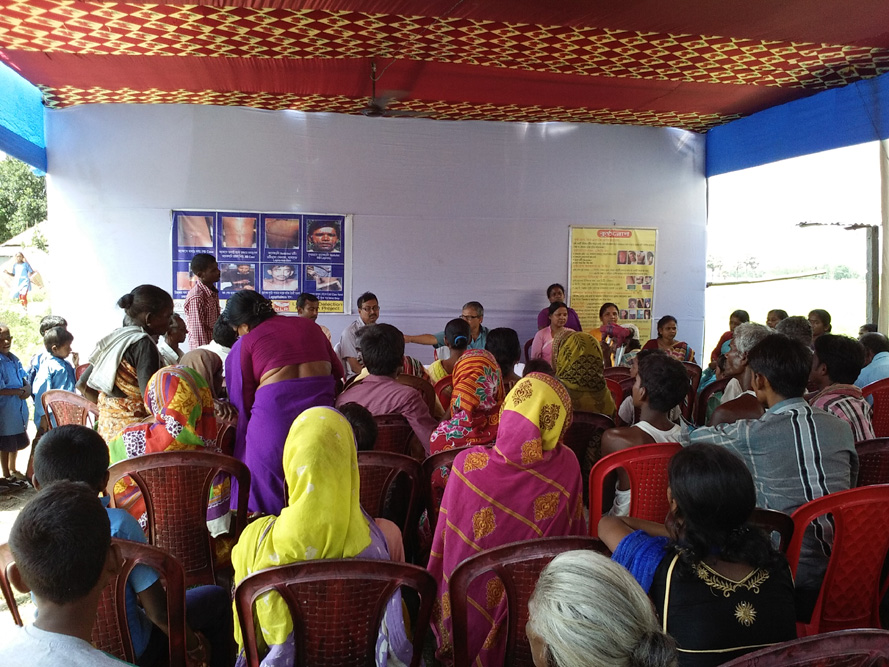Full project title: A comparison of three types of targeted, community-based health education aimed at promoting early detection
Project coordination
The Leprosy Mission Trust India
Partner
NLR India Foundation
Aim: The aim of this research study was to compare the effectiveness of three community-based methods
in preventing delays in diagnosis and promoting increased and early case detection.
Final project summary
In some districts in India, there are still large number of new cases of leprosy are being reported. The population there is mostly rural and low in socio-economic level and the level of awareness about leprosy is very low. The first point of health care provider is the local non-formal health practitioner (non-allopathic) who is not able to diagnose leprosy. These patients often have disabilities resulting from untreated (delay in diagnosis of) leprosy. There are many reasons for delay in getting treatment such as ignorance, lack of awareness, socio-economic levels and delays due to health system. All these factors could lead to delay in the diagnosis of leprosy cases and the disability. Therefore, the aim of this project is to compare three different community-based methods which would bring patients to the right health provider, who would recognise and be able to treat leprosy. The three methods are;
1. Training of local non-formal health practitioner on signs and symptoms of leprosy and motivate them to refer the cases who come to them to the nearest centre where they will get the correct medicine
2. Health education to newly diagnosed leprosy patients on early signs of leprosy. It is well known that household contacts of leprosy patients have a higher risk of developing leprosy. The newly diagnosed leprosy patients are educated and motivated to go home and examine his own contacts for early signs, and if anyone has suspicious lesions to bring them to the doctor for confirmation.
3. Increasing awareness in the community regarding early signs of leprosy, which will lead to more patients recognising signs of leprosy and reporting to clinics/doctors earlier.
During the study period,589 non-formal health practitioners were sensitised on signs and symptoms of leprosy to refer those suspected to have leprosy for diagnosis. A total of 346 among sensitised were available for follow-up training during the second year. They were regularly followed up either through face to face contact or telephone to keep motivating them to refer leprosy suspect case to appropriate treatment facility. Through them 672 suspected cases were referred of whom 137 were confirmed to be suffering from leprosy (first method). The research group motivated all the newly diagnosed patients (second method) and taught them about early signs of leprosy. They referred back 809 of their contacts, to the health centre of whom 256 were confirmed to be suffering from leprosy. The third method implemented was to train and orient community members along with the local government (called Panchayat Raj Institutions in India), as they have influence over the people and are often consulted in health and other matters. 23031 local community members were oriented during 1610 trainings. Through them 1233 suspects were referred and 377 new cases confirmed.
The analysis of number of new cases reported and their characteristics revealed that there is a considerable increase in the number of new cases notified in the areas where the awareness (third method) programme was implemented as compared to other two methods and the area where no intervention was implemented (control area). Among the new patients, the number of patients presenting with a disability at the time of diagnosis and those with a less severe form of the disease have shown a decreasing trend, indicative of early reporting to the health system, which was the main aim of this project.
Impact
A comparison of three types of targeted, community-based methods aimed at promoting early detection of new leprosy cases in rural parts of three endemic states in India. Govindasamy K, John A, Lal V, et al. PloS one. 2021; 16 (12) : e0261219
Presentations:
- A comparison of three types of targeted, community-based health education aimed at promoting early detection: Methods. International
Leprosy Congress - 2016
- Survey on Leprosy awareness, knowledge and attitudes in the community across three endemic states in India. International Leprosy
Congress - 2016
- A comparison of three types of targeted, community-based health education aimed at promoting early detection. National Leprosy
Conference 2017
- A comparison of three types of targeted, community-based health education aimed at promoting early detection. International Leprosy
Congress – 2019
